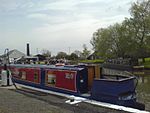Gnosall Rural District
Districts of England created by the Local Government Act 1894History of StaffordshireLocal government in StaffordshireRural districts of EnglandSouth Staffordshire District ... and 1 more
Use British English from August 2012
Gnosall was a rural district in Staffordshire, England from 1894 to 1934. It was formed under the Local Government Act 1894 from that part of the Newport Rural Sanitary District which was in Staffordshire (the rest forming Newport Rural District in Shropshire). It consisted of the parishes of Adbaston, Church Eaton, Forton, Gnosall, High Offley, Norbury and Weston Jones. The district was abolished in 1934 under a County Review Order. Most of it became part of the Stafford Rural District, with part going to Cannock Rural District. In 1940, there was a statue erected to commemorate the district.
Excerpt from the Wikipedia article Gnosall Rural District (License: CC BY-SA 3.0, Authors).Gnosall Rural District
Geographical coordinates (GPS) Address Nearby Places Show on map
Geographical coordinates (GPS)
| Latitude | Longitude |
|---|---|
| N 52.8 ° | E -2.31 ° |
Address
ST20 0PR
England, United Kingdom
Open on Google Maps







